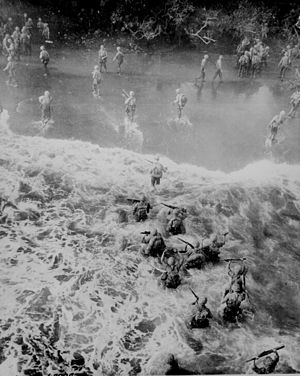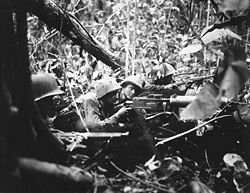- Battle of Cape Gloucester
-
Battle of Cape Gloucester Part of World War II, Pacific War 
U.S. Marines hit three feet of rough water as they leave their LST to take the beach at Cape Gloucester, New Britain. December 26, 1943. (Source: U.S. National Archives.)Date December 26, 1943 – April 22, 1944 Location Cape Gloucester, New Britain, Territory of New Guinea Result Allied victory Belligerents  United States
United States
 Australia
Australia Empire of Japan
Empire of JapanCommanders and leaders William H. Rupertus Iwao Matsuda Casualties and losses 310 killed
1,083 wounded1,000 killed Arawe – Cape Gloucester – Talasea – Gasmata – Jacquinot Bay – Wide Bay – Open BayThe Battle of Cape Gloucester was a battle in the Pacific theater of World War II, which took place between late December 1943 and April 1944, on the island of New Britain, part of the Territory of New Guinea.
The battle was a major part of Operation Cartwheel, the main Allied strategy in the South West Pacific Area and Pacific Ocean Areas during 1943-44, and it was the second World War II landing of the U.S. 1st Marine Division, after Guadalcanal.[1]
Contents
Objectives
The main objective of the American and Australian allies was the capture and expansion of the Japanese military airfield at Cape Gloucester.[2] This was to contribute to the increased isolation and harassment of the major Japanese base at Rabaul. A secondary goal was to ensure free Allied sea passage through the straits separating New Britain from New Guinea.
Supporting operations for the landings in Cape Gloucester began on December 15, when the U.S. Army's 112th Cavalry Regiment was landed at Arawe on the south-central coast to block the route of Japanese reinforcements and supplies from east to west and as a diversionary attack from the future Cape Gloucester landings.
The main operation began on December 26 with a naval barrage on the Japanese positions on Cape Gloucester by U.S. Navy and Royal Australian Navy (RAN) warships, followed by air attacks by planes from the U.S. Army Air Forces (USAAF) and Royal Australian Air Force (RAAF). These attacks and an aerial smoke screen were followed by the landing of the U.S. 1st Marine Division, at Yellow Beach 1 & 2 and Green Beach, under the command of Major General William H. Rupertus. The Marines faced swampy terrain and thick jungle, but met only rear-echelon Japanese troops.
The Marines were opposed by the Japanese 17th Division, commanded by Major General Iwao Matsuda, which was augmented by "Matsuda Force"—the 65th Infantry Brigade and elements of the Japanese 51st Division, the main body of which continued to resist Allied offensives on mainland New Guinea. Matsuda's headquarters was at Kalingi, along the coastal trail northwest of Mount Talawe, within five miles (eight kilometres) of the Cape Gloucester airfield.
References
- ^ "1st Tank Battalion History". Official Website - 1st Marine Expeditionary Force. http://www.i-mef.usmc.mil/div/1tnks/History.asp. Retrieved 2010-03-28.
- ^ "Capture of the Cape Gloucester Airfields". National Park Service - Marines in World War II. http://www.nps.gov/archive/wapa/indepth/extContent/usmc/pcn-190-003128-00/sec6.htm. Retrieved 2010-03-28.
Bibliography
- Hough, Frank O., and John A. Crown (1952). "The Campaign on New Britain". USMC Historical Monograph. Historical Division, Division of Public Information, Headquarters U.S. Marine Corps. http://www.ibiblio.org/hyperwar/USMC/USMC-M-NBrit/index.html. Retrieved 2006-12-04.
- Miller, John, Jr. (1959). "CARTWHEEL: The Reduction of Rabaul". United States Army in World War II: The War in the Pacific. Office of the Chief of Military History, U.S. Department of the Army. pp. 418. http://www.ibiblio.org/hyperwar/USA/USA-P-Rabaul/index.html. Retrieved October 20, 2006.
- Shaw, Henry I.; Douglas T. Kane (1963). "Volume II: Isolation of Rabaul". History of U.S. Marine Corps Operations in World War II. http://www.ibiblio.org/hyperwar/USMC/II/index.html. Retrieved 2006-10-18.
External links
Categories:- Conflicts in 1944
- 1944 in Papua New Guinea
- Battles and operations of World War II involving Papua New Guinea
- South West Pacific theatre of World War II
- Battles of World War II involving Australia
- Battles of World War II involving the United States
- Battles of World War II involving Japan
- United States Marine Corps in World War II
Wikimedia Foundation. 2010.

